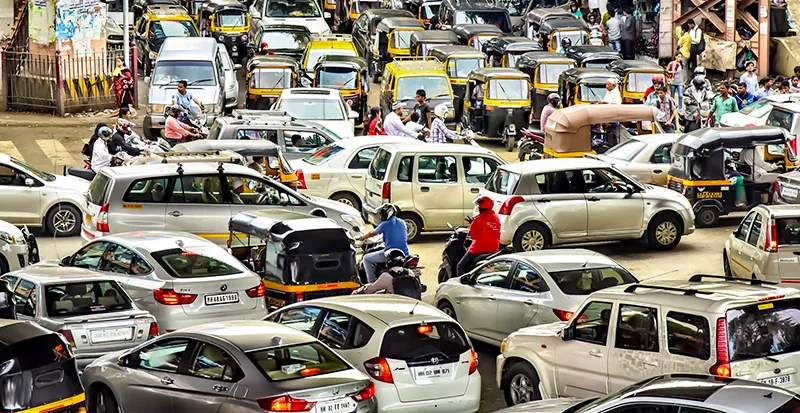Why urban mobility needs a new roadmap for the future
Urban mobility needs to be relooked at and solutions sought, keeping in mind the present and future contours of growth and sustainability needs
Urbanisation has transformed India and while it has been an instrument of social, economic, and political progress, many attendant challenges, especially environmental and socio-economic, have arisen in recent years.
One of the key and perhaps most pressing aspects of rapid urbanisation in India has been the rise in the challenges faced by urban mobility. The increase in population density in urban areas, coupled with the growth in the number of vehicles on the roads, has resulted in severe traffic congestion, longer travel times, and increased air pollution.
Traffic congestion, pollution, pedestrian areas, parking and jams, road accidents, inadequate public transport, etc., have become commonplace in our cities. This is the situation with only 35% of our population concentrated in cities.
By 2050, urbanisation is expected to cross 70%, which is anticipated to add to the challenges that urban mobility faces today.

There has been an upward trend of urbanisation in India over the past few years, leading to more vehicles on roads.
Urban mobility needs to be relooked at and solutions sought for addressing these problems on a war footing, keeping in mind both the present and future contours of growth and sustainability needs. For this, it is necessary to understand what ails urban commuters so that a fuller appreciation of the road ahead is possible.
Post-pandemic, traffic congestion is now reaching close to and equalling pre-pandemic levels. The TomTom Traffic Index, a venerable listing of global cities ranked by traffic density, has three Indian cities—Mumbai, Bengaluru, and Delhi in the top 10. This should not really surprise anyone since over 21 crore two-wheelers and 7 crore four-wheelers and above category of vehicles are currently registered in India.
With such a large number of vehicles on the roads, traffic flow becomes slow, leading to very long commute times and increased stress levels for commuters. This not only affects productivity of individuals but also contributes to air pollution and reduces the overall quality of life in cities.
Rising levels of particulate matter in the air due to vehicle emissions lead to health problems such as asthma and bronchitis among city dwellers, while affecting their immunity and making them prone to other health issues.
With an increase in traffic congestion, since the road network within cities is fast getting choked and filled to capacity, inequity in transport is also becoming a major issue. Many people who cannot travel by private vehicle face the harsh reality of poor public transport.
On the other hand, public transport, while affordable and recommended, has the drawback of first and last-mile connectivity, thereby deterring commuters who wish to use this mode of transport.

Increase in vehicular traffic leads to increase in air pollution, contributing to health problems.
Another issue that has reared its head in the wake of increased urbanisation and put a spanner in the works for urban commuters is air pollution. Smog and other particulate matter suspensions in the atmosphere, in and around cities, is a very serious problem these days. Impure and hazardous air quality is now as much a characteristic of our cities as are high-rises and traffic snarls. The increasing number of vehicles has upped the levels of air pollution, leading to serious health problems ranging from respiratory problems to heart disease.
Poor and unhealthy air can be due to a variety of reasons, but vehicular pollution is a major contributor in most cities. This is in direct correlation to a city’s population density and growth, and therefore needs to be addressed in a systematic manner.
In addition to the above, there are innumerable mobility challenges facing commuters in cities, which arise from such issues as social barriers, poor city planning, and lack of supporting infrastructure.
In developing countries, such as India, the problem is particularly acute. Most of our cities have inner areas composed of a mesh of narrow streets often accessible only to non-motorised traffic.
Michael Thomson’s classic book Great Cities and Their Traffic (1977) provides a breakdown of the ways in which most people are dissatisfied with the transport systems of their cities and this problem has only transformed into one of gigantic proportions with the passing years.
To maintain the twin demands of sustainability and tech advancement as well as provide the necessary quality of life to residents, our urban mobility issues need an intelligent, innovative, convenient, and feasible solution in the form of the next generation of electric vehicles that come with a compact design with premium aesthetics, and lower running costs, maintenance, and emissions.
It is important for cities to implement a holistic and sustainable approach to urban mobility to address challenges faced by commuters. Ultimately, a comprehensive and coordinated approach involving multiple stakeholders, including the government, private sector, and citizens, is necessary to address the issue of deteriorating urban mobility in India.
Gaurav Gupta is Chief Commercial Officer at MG Motor India.
Edited by Teja Lele
(Disclaimer: The views and opinions expressed in this article are those of the author and do not necessarily reflect the views of YourStory.)







